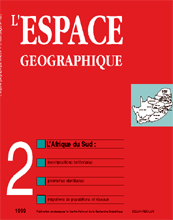

South Africa
New South Africa, new territories, new identities (1 tabl., 4 fig.)
Since 1994, South Africa has completely redrawn its internal boundaries at the provincial and local level. The new boundaries are intended to replace the previous ones which had been drawn to separate people according to there «race» and «ethnicity». This paper deals with the consequences of this spatial reorganisation according to identity, on two different scales: the new provinces and the Johannesburg metropolitan area.
keywords: APARTHEID, BOUNDARIES, IDENTITIES, JOHANNESBURG, METROPOLITAN AREAS, PROVINCES, SOUTH AFRICA, TERRITORIES
Antoine BOUILLON. Transition and territorial principles in South Africa, races, immigrations, territories and networks (1 fig.)
With the demise of apartheid and the transition to democracy, South Africa's territorial principles have been transformed, giving way to a new arrangement that combines territorial principles that existed in the past with those derived from recent changes: far from giving way to a homogeneous system, this transformation is an increasingly complex mixture of former apartheid territorial tractice, the Westphalian territorial principle underpinning the political dispensation of the "New" South Africa and the networks formed by the continental migratory economy driven by the African migrants who have flocked to the country since transition.
keywords: MIGRATION, NETWORKS, SOUTH AFRICA, STATE, TERRITORY, TRANSITION
Immigration and the rise of xenophobia in South Africa: the case of Mozambicans in the township of Alexandra (1 fig.)
Since the beginning of the 1990's, a massive influx of illegal immigrants hassparked a rise of xenophobia in South Africa. Under the apartheid system, xenophobia was a purely racial, internal affair. Now it is mainly Black South Africans who are rejecting immigrants from the rest of the continent. When neighbouring countries such as Mozambique, are involved, the issue takes on national, ethnic and territorial dimensions, especially in urban townships like Alexandra in Johannesburg.
keywords: ILLEGAL IMMIGRATION, JOHANNESBURG, MOZAMBIQUE, SOUTH AFRICA, XENOPHOBIA
Coloured people in Cape Town: two problems of identity (2 tabl., 2 fig.)
The coloured population, of slave descent and extremely heterogeneous, now faces a major identity problem : apartheid forced an intermediate identity on Coloureds, between Whites and Blacks, which combined relative privileges with socio-political oppression. A redefinition of identity is now occuring under the new democratic order and this paper examines two of its most extreme forms : the massive coloured vote in favour of the National Party, responsible for apartheid, and the emergence of violent social movements such as criminal gangs and anti-crime groups, influenced by Islamic fundamentalism.
keywords: CAPE TOWN, COLOURED, CRIME, IDENTITY, POLITICAL GEOGRAPHY, SOUTH AFRICA
Philippe GUILLAUME. Urban life in townships. A study of Kliptown (Soweto) (3 fig., 4 phot.)
Constructing a more equitable urban environment is clearly one of the major challenges of the post-apartheid era. This paper aims to analyse the typical apartheid space of the township and, through the specific case of Kliptown, Soweto, to suggest some broad outlines for urban development.
keywords: SOUTH AFRICA, SOWETO, TOWNSHIP, URBAN DEVELOPMENT, URBAN LIFE
Philippe GERVAIS-LAMBONY, Bruno GUILLAUME. Odi-Moretele: "displaced urbanisation" and territorial reintegration in South Africa (2 fig.)
In the Pretoria metropolitan area the principles of «Grand Apartheid» were almost fully applied. A large proportion of the black population was forced to live far from the city, in the Bantustans. This «displaced urbanisation», so typical of the apartheid system, is now a challenge for the new authorities. The paper analyses the policy of territorial reintegration in one of these areas (Odi-Moretele in the former Bantustan of Bophuthatswana), with particular attention to urban management and governance. The water supply system is used as a practical example.
keywords: APARTHEID, BANTUSTAN, BOPHUTHATSWANA, BOUNDARIES, CITY, LOCAL GOVERNMENT, PRETORIA, SOUTH AFRICA, WATER
Laurent LHOPITALLIER, Patrice CARON. Diversity and recomposition of rural space in the district of Amatola, Eastern Cape Province (7 fig.)
A model of spatial organisation and dynamics in a South African district shows up clearly delimited, dissymetrical spaces produced by the policy of apartheid. Migratory movements and the spatial distribution of the population and of the urban and industrial centres highlight a gravity pattern, with a hierarchy of secondary and tertiary centres gravitating around East London. The limites of administrative entities are a poor fit to the lattice formed by the communication routes and the hierarchy of towns. Flows of people, goods, capital and information reveal an interdependence and the existence of complex, entangled networks. The analysis points up the regional development measures needed to correct the legacy of a segregated development policy.
keywords: AMATOLA, BANTUSTAN, REGIONAL DEVELOPMENT, SOUTH AFRICA, ZONING
L’espace géographique 1/99![]()
![]() L’espace géographique 3/99
L’espace géographique 3/99
For subscribe or buy this issue: BELIN
![]() L’Espace géographique: contents
L’Espace géographique: contents
Last modified: May 17, 1999